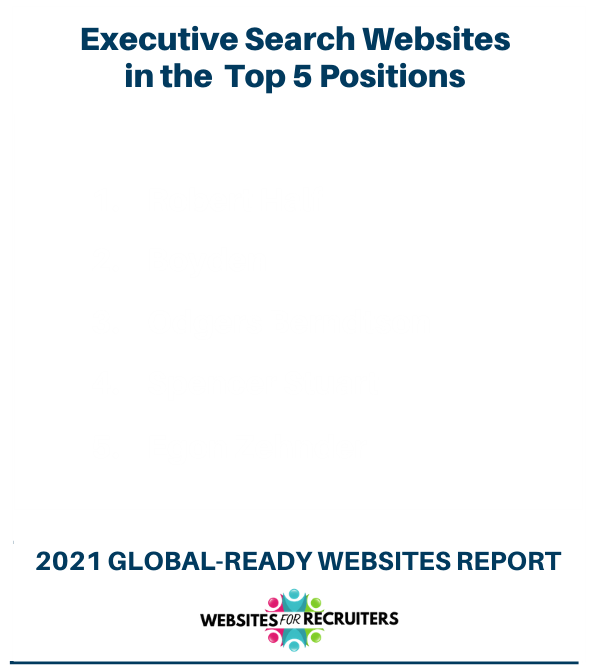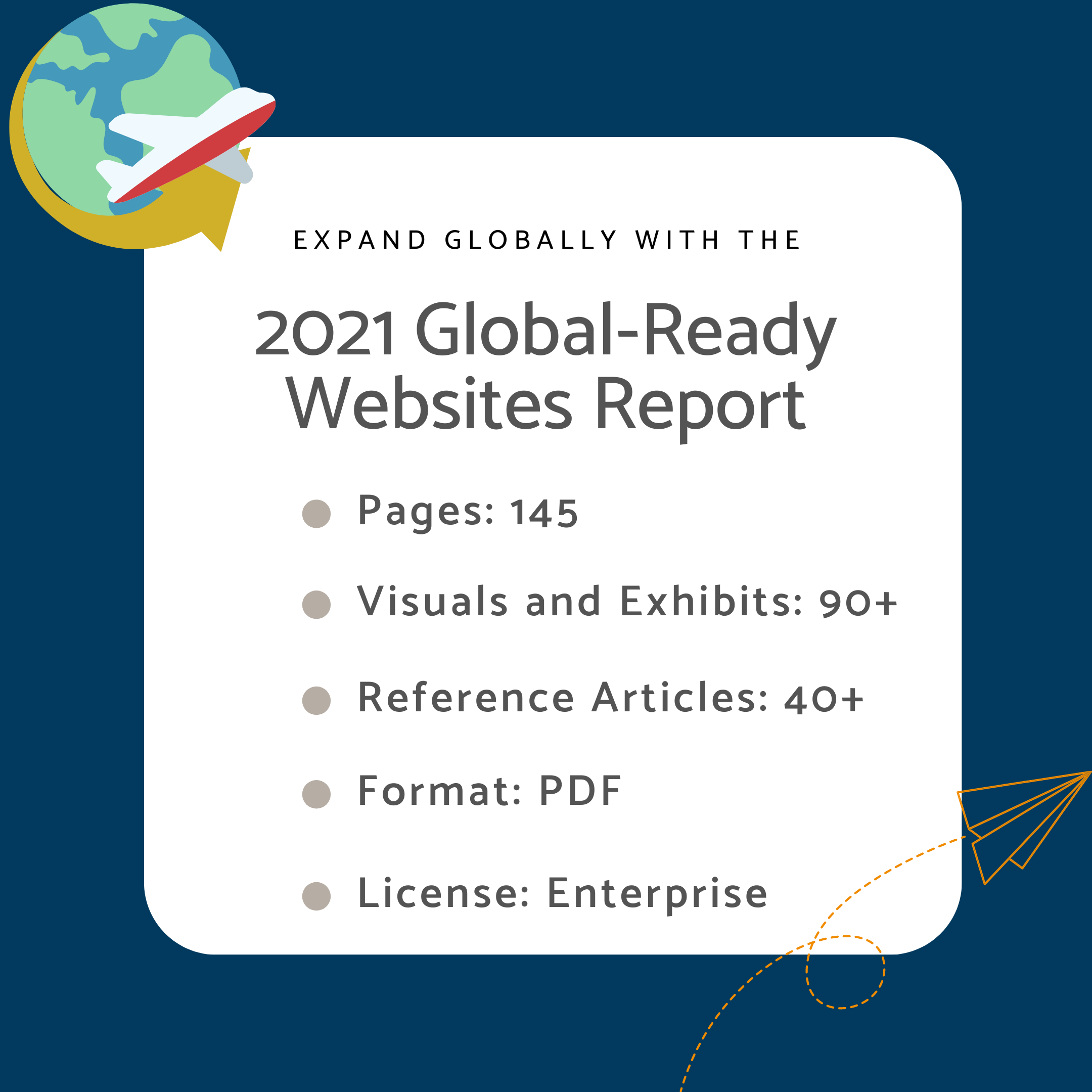Now Available!
2021 Global-Ready Websites Report
Produced Exclusively For The U.S. Executive Search Industry
From Robert Half to Wittkieffer to Acertitude — an in-depth analysis of the United States’ leading executive search firm websites, with a particular special focus on cross-cultural user-experience.

A client in FinTech looking for competitive advantage in the UK market will want to choose a firm with deep expertise in both that sector and geographic market.
Demonstrate deep expertise in global markets with a global-ready website
Cultural nuances influence local work and hiring environments in markets worldwide.
For U.S.-based Retained Executive Search firms to strengthen their footprint in global markets, demonstrating an in-depth, “insider” knowledge of these nuances gives you a competitive advantage.
Designing your website to do the heavy-lifting of communicating your firm’s values and expertise to a culturally-diverse, global audience is a productive, cost-effective strategy.
The 2021 Global-Ready Websites Report, produced exclusively for U.S.-based executive search firms answers questions such as:
- What does it mean to have a global-ready website?
- How can a focus on interculturality lead to sales growth?
- Which best practices are our competitors following?
- Which web design attributes and common practices impede international users?
- What untapped opportunities are we and our competitors missing to increase local website traffic in markets abroad?
Through website profiles, loaded with screenshots, you’ll learn which practices to emulate and which to avoid. A combination of quantitative data and deep study of intercultural web design practices make this report an invaluable resource for any executive search firm in the United States wanting to expand in global markets.
50 Global executive search firm websites benchmarked
To support client acquisition marketing strategies for 2021, we benchmarked 50 executive search firm websites, of which 37 are headquartered in the United States. These websites comprise 46% of the companies on Huntscanlon’s Global 40 list, 42% of Forbes 2020, and 12% of Huntscanlon’s Top 50, ensuring a broad reach of the leading global executive search firm businesses.
How to use the Global-Ready Website Report
Global business leaders are looking inwards and focussing on enhancing the ‘human’ experience with all stakeholders. With a growing demand for executive talent in emerging economies in the Asia/Pacific region, Eastern Europe, and Africa, cross-cultural website user experiences for effective communication becomes a priority.
This report serves two purposes. First, it spotlights those websites that have elevated their global readiness through a culturally focused web design. They have demonstrated their priority for the ‘human’ experience, thus building trust and brand reputation. This, in turn, is what leads to more consumers and more sales.
Second, this report identifies current practices (both positive and negative) to help you avoid the painful missteps that others have already taken. This report is designed to help you guide your web, marketing, content, mobile and local teams to positive, efficient action.

Who this report is for:
Managing Partners and Directors responsible for international business initiatives can use this report to evaluate and capitalize on the competitive advantage of intercultural user experiences. The report ranks the top firms maximizing culture-centered web assets. You’ll also see what gaps still exist, even for large executive search firms. The information is written in non-technical terms, and uses a number of visuals to illustrate examples.
Marketing Executives can use the report to evaluate and enhance the cross-cultural effectiveness of their global communications plans. This report identifies opportunities for making more effective use of your website in combination with social media platforms like LinkedIn to reach international audiences. Plenty of visuals and a term glossary make the report accessible to every member of the team.
In-house IT Webmasters now have the opportunity to find out what web design attributes and functionalities need to go and what can stay in order to boost engagement metrics and support lead generation goals. No more guessing what works, as this report confirms the best cross-cultural web design practices relevant to the executive search industry.
Click here to receive the sample copy of the report.
Top 5 Global-Ready Executive Search Firm Websites For 2021
Robert Half tops the list with a website design that powerfully communicates with a global audience using cultural-sensitive design elements and functionalities.
Boyden scales the overseas markets with an underutilized web design strategy that makes it ‘feel like home’ for a first-time visitor.
Odgers Berndtson demonstrates their global focus by following best web design practices for a cross-cultural user-experience, that can be emulated to attract a global audience.
Spencer Stuart keeps it simple, modern, and focused on their key target markets, through a design strategy that enhances website engagement.
Egon Zehnder has created ‘light’ templates for their target markets and enhanced them to engage with the local audiences.
The report provides a real world view by comparing U.S. executive search websites with some of the leading names in the industry that have origins in other markets.
More about current and best practices in intercultural web design is covered in wider detail inside the report. Click here to purchase the report.

Table of Contents
- A Global Template to Build a Global Audience
- A Business Case for Website Internationalization
- Executive Search Websites in the Top 5 Positions
- 5 Most Promising Executive Search Websites
Part 2: Journey toward Website Globalization and Best Practices
- Combining Web Usability with Culture for a Wider Audience Reach
- 3 Essential Milestones in the Journey toward Global-Ready Websites.
- Website Internationalization
- The Most Underutilized Traffic Engagement Website Feature Relevant For Global Audiences
- Can the Global Template be relied on to Communicate Effectively to Business Leaders and Candidates In Key Markets?
- Language Translation
- Which Languages Should your Website Offer?
- Content Prioritization for Design and Translation
- Website Localization
- Website Globalization
- Cost Savings by Planning Your Website Strategy in Advance
- Are Recruitment Networking Sites Creating The Right Impact?
- The Global Template Strategy for Partner Search Firms
- Responsiveness: Stepping It Up Beyond Screen Adaptability
Part 3: Methodology
- How the Websites Were Selected
- The 50 Executive Search Firms Benchmarked
- Benchmarking Guidelines
- Scoring System
Part 4: Website Scores
- Website Scores
- How Do Non-U.S. Websites Compare?
- Undivided Attention for Lead Generation
- Executive Search Firms with the Highest Website Traffic from LinkedIn
- LinkedIn strategy built on Cultural Intelligence and Thought Leadership
- Checklist to Successfully Set Up an Intercultural LinkedIn Presence
Part 5: Website Profiles by Company (The 50 Executive Search Firm Websites Benchmarked)
- 20/20 Foresight Executive Search
- ACCUR Recruiting Services
- Acertitude
- AIMS International
- Allegis Partners
- Alto Partners
- August Leadership
- Barbachano International
- Boyden
- Calibre One
- Catalyst Advisors
- Cornerstone International Group
- DHR International
- Egon Zehnder International
- EMA Partners
- Experis by Manpower
- H.I. Executive Consulting
- Heidrick & Struggles
- IIC Partners Executive Search Worldwide
- International Executive Search Federation
- Intersearch Worldwide Ltd
- IRC Global Executive Search Partners
- Korn Ferry
- Major, Lindsey & Africa
- Mcdermott + Bull
- Mercuri Urval
- MRI Network
- N2Growth
- NPA Worldwide
- Odgers Berndtson
- Options Group
- Page Executive
- Reaction Search International
- Resources Global Professionals
- RGF Executive Search
- Robert Half
- RSR Partners
- Russell Reynolds Associates
- Solomon Page
- Spencer Stuart
- Stanton Chase
- Steven Douglas
- The Alexander Group
- The Barrett Group
- The Caldwell Partners International
- Transearch International
- True
- Vaco
- WittKieffer
- ZRG Partners
About the Author
Supporting U.S.-Based Growth-Stage Retained Executive Search Firms
Desiree Silveira is an Intercultural Communications Consultant who specializes in International Website Design & Cross-Cultural User Experience.
Unlike broad-market “recruiting website” designers, Desiree’s Global-Ready Design framework fuses culturally-intelligent design and “insider” knowledge of the local work and hiring culture in regions throughout the South Asian and Middle Eastern markets. So she’s uniquely equipped to help firms strengthen their global footprint by differentiating their brand online in culturally-relevant ways.
Previously, Desiree led corporate HR and executive search functions for international organizations based in India and the Middle-East.

Desiree Silveira, Intercultural Communications Consultant
